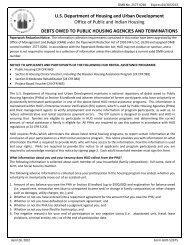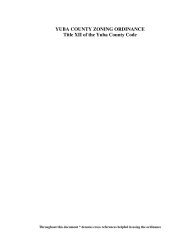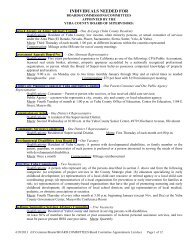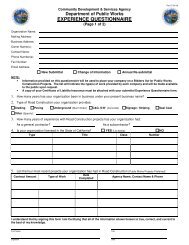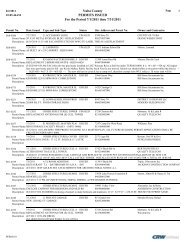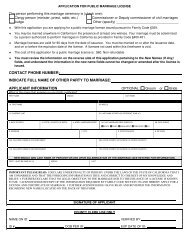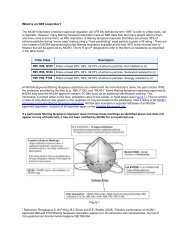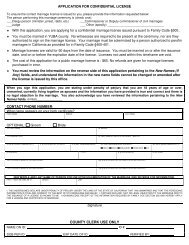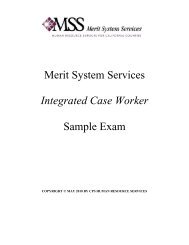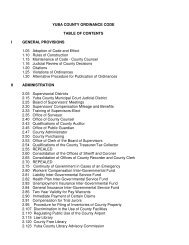OWNER BRIEFING PACKET S ECTION 8 - Yuba County
OWNER BRIEFING PACKET S ECTION 8 - Yuba County
OWNER BRIEFING PACKET S ECTION 8 - Yuba County
You also want an ePaper? Increase the reach of your titles
YUMPU automatically turns print PDFs into web optimized ePapers that Google loves.
<strong>Yuba</strong> <strong>County</strong> Housing Authority<br />
915 8 th Street, Suite 130<br />
Marysville, Ca 95901<br />
Phone: 530-749-5460
TABLE OF CONTENTS<br />
Chapter 1 Introduction .................................................................................................................................................. 3<br />
Chapter 2 General Program Information ...................................................................................................................... 5<br />
Chapter 3 Becoming a Participating Landlord .............................................................................................................. 8<br />
Chapter 4 Obligations ................................................................................................................................................. 26<br />
Chapter 5 Terminations .............................................................................................................................................. 37<br />
Chapter 6 Program Benefits ....................................................................................................................................... 39<br />
Chapter 7 Glossary of Section 8 Housing Terms ....................................................................................................... 41<br />
Chapter 8 Forms ........................................................................................................................................................ 51<br />
2
Chapter 1 Introduction<br />
Goal of the Section 8 Housing Program<br />
This guidebook has been prepared in appreciation of your interest in participating in the Section 8 Tenant-Based<br />
Assistance Program.<br />
The rules and regulations for the Section 8 Housing Choice Voucher Program are determined by the U.S. Department<br />
of Housing and Urban Development (HUD). If you are a rental property owner or manager, this handbook will assist you in<br />
understanding how the programs work.<br />
The success of the program depends on the local Public Housing Agency (PHA) being able to contract with property<br />
managers and owners who have decent, safe, and sanitary rental units. Although the program was designed to be<br />
voluntary, in some states (e.g.,Connecticut) it is illegal to simply refuse a tenant because he or she is a participant in the<br />
Section 8 Program. Check with your local or state human rights agency to find out what the fair housing laws are in your<br />
state. Many low-income families in your community rely on owners like you who are willing to participate in the program.<br />
In most communities, there is a shortage of decent and affordable housing. The subsidy that comes with the Section 8<br />
Program helps families to rent in many different neighborhoods. Participant families include elderly persons, persons<br />
with disabilities, and working families who do not earn enough to keep pace with rising rental housing costs.<br />
Housing Agency Service Commitment<br />
As a public service agency, the Public Housing Agency’s goal is to provide excellent service to the families and owners<br />
participating in the Section 8 Program. The PHA will make every effort to inform you of the program rules and to advise<br />
you of how these rules affect you. Since federal regulations are not always easy to understand, it is very important to ask<br />
questions understand if you are not sure of something.<br />
3
Do not hesitate to contact a PHA representative if you have a questions or problem that pertains to one of the housing<br />
programs.<br />
Definitions<br />
In order to explain the Section 8 Housing Choice Voucher Program, it is necessary to use certain housing terms. For this<br />
reason a glossary of commonly used housing terms has been included in the back of this handbook. As you read through<br />
the text, you will notice that many terms appear in bold italics the first time they are used. You will find these and other<br />
terms in the glossary.<br />
Getting in Touch with You<br />
Since the PHA may need to contact you from time to time, be sure they have a daytime phone number where you can be<br />
reached. After the initial lease-up period, most of your contact with the PHA will probably be by first-class mail.<br />
Your cooperation in essential to the PHA’s being able to serve you and any family you may select as a renter.<br />
4
Chapter 2 General Program Information<br />
Responsibilities Within the Section 8 Program<br />
The Section 8 Housing Choice Voucher Program is a three-way partnership among the Public Housing Agency (PHA), the<br />
tenant, and the owner or landlord of the housing unit (you).<br />
Housing Agency’s Job<br />
In order for the program to work, the PHA must do the following:<br />
Review all applications to determine whether and applicant is eligible for the program<br />
Explain all the rules of the program of the families who qualify.<br />
Issue a Voucher and, if necessary, assist the family in finding a place to live.<br />
Approve the unit, the owner, and the tenancy.<br />
Make housing assistance payments to the owner in a timely manner.<br />
Ensure that both the family and the unit continue to qualify under the program.<br />
Ensure that owners and families comply with the program rules.<br />
Provide families and owners with prompt service.<br />
5
Owner’s Job<br />
In order for the program to work, the owner has a right or responsibility to:<br />
Screen families who apply to determine if they will be good renters. The PHA can supply you with the current and<br />
previous address and landlord information. The PHA may also provide additional information pertaining to a<br />
tenant’s performance as a renter.<br />
Consider a family’s background regarding factors such as:<br />
Paying rent and utility bills<br />
Caring for the property<br />
Respecting the rights of others to peaceful enjoyment of their residences<br />
Engaging in drug-related criminal activity or other criminal activity that is a threat to life, safety, or the<br />
property of others<br />
Compliance with other essential conditions of tenancy<br />
Comply with fair housing laws and discriminate against no one.<br />
Maintain the housing unit by making necessary repairs in a timely manner.<br />
Comply with the terms of the Housing Assistance Payments (HAP) Contract with the Housing Agency.<br />
Collect the rent due by the tenant and otherwise enforce the lease.<br />
6
Family’s Job<br />
In order for the program to work the family must do the following:<br />
Provide the PHA with complete and accurate information.<br />
Make their best effort to find a place to live that is suitable for them and qualifies for the program.<br />
Cooperate in attending all appointments scheduled by the PHA.<br />
Take the responsibility for the care of their housing unit.<br />
Comply with the terms of their lease with the owner.<br />
Comply with the family obligations of their Voucher<br />
7
Chapter 3 Becoming a Participating Landlord<br />
Steps for Interested Owners<br />
If you have one or more rental units and are interested in the program, you may call your local Housing Agency at any<br />
time during business hours. The PHA may mail you a packet of information and may offer to schedule at owner<br />
orientation for you. If you decide to participate in the program, be prepared to furnish proof of legal ownership of any<br />
unit(s) that you offer under the program. This is one of HUD’s requirements for the program<br />
Step 1<br />
Tenant Found<br />
A prospective tenant will come to you with a Voucher in hand.<br />
Step 2<br />
Tenant Approved by Owner<br />
Even though a family is determined by the PHA to be eligible for the program, the owner must approve the family as a<br />
suitable renter. The PHA knows that the owner has approved the family when a Request for Tenancy Approval (RFTA)<br />
form is submitted.<br />
8
Step 3<br />
Tenancy and Unit Approved by PHA<br />
After a family finds a suitable housing unit and the owner approves the family, the Housing Agency needs to determine if<br />
the unit qualifies for the Section 8 Program. This includes a Housing Quality Standards inspection. If the unit does not<br />
pass inspection, a reasonable time will be given to make the required repairs.<br />
Step 4<br />
Contract and Lease Signed<br />
If the unit meets the program requirements and the tenancy can be approved, the PHA will enter into a Housing<br />
Assistance Payments (HAP) Contract with the owner, and the family will enter into a lease with the owner.<br />
Step 5<br />
Housing Assistance Payments Made<br />
After the HAP Contract and lease are signed, the PHA makes the initial payment and continues to make monthly<br />
payments to the owner as long as the family continues to meet eligibility criteria and the housing unit qualifies under the<br />
program.<br />
9
Step 1: Tenant Found<br />
When a family is determined to be eligible for the program and funding is available, the Public Housing Agency (PHA)<br />
issues the family a Housing Choice Voucher. The family receives the voucher at the tenant briefing. They then begin<br />
looking for a unit.<br />
When you first see a Section 8 family, they will already have been issued a Voucher.<br />
Step 2: Tenant Approved by Owner<br />
You should use the same diligence in screening a potential Section 8 tenant as you would any other tenant. To start, ask<br />
to see his or her Voucher.<br />
Review the Voucher<br />
Check the expiration date to determine whether the Voucher is still valid. Vouchers expire on this date unless they<br />
have been extended by the PHA.<br />
Check the unit bedroom size for which the family has been approved. It will be stated on the voucher<br />
Screen the family<br />
When you are contacted by a prospective renter, evaluate him or her as you would any other renter.<br />
Make sure that your tenant selection standards are based on objective business-related considerations, such as<br />
previous history of nonpayment, damage to property, or disturbance of neighbors.<br />
10
Owners must apply the same standards of tenant selection to any family that applies, whether the family is a<br />
prospective Section 8 renter or not. Tenant selection must not be based upon race, color, age, religion, sex,<br />
familial status, disability, or any other discriminatory factors.<br />
The PHA does not screen families for their suitability as renters. That is the job of the owner.<br />
Security Deposits<br />
The owner may collect a security deposit. The tenant is responsible for payment of the security deposit.<br />
Step 3: Tenancy and Unit Approved by the PHA<br />
HUD requires that any lease signed by a Section 8 tenant must include the HUD Tenancy Addendum (see copy in<br />
Chapter 8), and the PHA must approve the tenancy before the lease is signed.<br />
Leasing Process<br />
You must submit you own lease to the PHA along with a Request for Tenancy Approval (RFTA) form. The PHA may<br />
review the lease to make sure it does not contain any provision that conflicts with the program rules or state law.<br />
The lease must specify all of the following:<br />
Name of the owner<br />
Name of the tenant<br />
Unit rented (address, apartment number, and any other information needed to identify the unit)<br />
11
Term of the lease<br />
Initial term<br />
Provisions for renewal terms<br />
Amount of the monthly rent to owner<br />
Utilities and appliances to be supplied by the owner<br />
Utilities and appliances to be supplied by the tenant<br />
The lease should include the amount of the security deposit. Your lease should also address renewal terms, notice period<br />
for termination of tenancy, and rent increases after the initial term.<br />
Request for Tenancy Approval<br />
The family was given a Request for Tenancy Approval (RFTA) form at its tenant briefing. When you provide the signed<br />
RFTA to the PHA, it will be reviewed to determine if the unit is the correct size and the proposed rent is approvable.<br />
RFTA<br />
Lease<br />
Tenancy<br />
Addendum<br />
Must be completed &<br />
signed<br />
12
Tenancy Addendum<br />
In addition to the RFTA, you must submit to the PHA your standard lease for unassisted tenants with the HUDrequired<br />
Tenancy Addendum attached to it.<br />
Important Information about the Lease Agreement<br />
The lease agreement must comply with the state and local law.<br />
The Housing Assistance Payments (HAP) contract between the PHA and the owner begins on the first day of the<br />
term of the lease and ends on the last day.<br />
The initial term of the lease must be for at least one year unless the PHA approves a shorter term. The PHA<br />
approves a shorter term. The PHA may approve a shorter term under the following two conditions:<br />
o A shorter term would improve housing opportunities for the tenant.<br />
o Shorter terms are the prevailing market practice.<br />
Inspection Process<br />
On receipt and review of the Request for Tenancy Approval, the PHA will notify you and your tenant of the date and time<br />
of the Housing Quality Standards inspection. You or your representative should be there.<br />
If the unit passes the initial inspection and the necessary paperwork, and the tenant assistance will begin. Many Has<br />
execute HAP Contracts only on the first of the month while others will put families under contract in the middle of the<br />
13
month prorate the first month’s HAP. Check with your local PHA for its policy on the date of HAP Contracts. If the unit<br />
does not pass the initial inspection, you will be given a reasonable time period to correct any items that failed.<br />
Meeting Housing Quality Standards (HQS)<br />
Before the PHA can make payments to you on behalf of a tenant family, the unit must meet HUD’s minimum Housing<br />
Quality Standards. These standards have been implemented by HUD nationwide to ensure that all assisted units meet<br />
minimum health and safety standards. The booklet “A Good Place to Live” describes the general aspects of a unit that<br />
must be inspected for compliance with HQS. You may obtain much more detailed information from your PHA<br />
representative about additional standards that may be required under local code.<br />
Prepare the Unit for Inspection<br />
Review the information on Housing Quality Standards as you evaluate your rental unit. Try to correct any HQS<br />
violations before the inspection. At the time of the inspection, the unit should be “move-in” ready. This will prevent<br />
delays in the beginning of the family’s rental assistance. If the family is already in the unit, it is a good idea to go<br />
over the checklist with them to ensure that the unit will meet the minimum requirements.<br />
Participate in the Inspection<br />
You and the family will receive written notification of the date and time of the unit inspection. Take advantage of<br />
this opportunity to meet the inspector and to discuss the various aspects of the inspection. It will help you to learn<br />
more about HQS so that you will know how best to prepare for other inspections. Once you go through an<br />
inspection, you will have a keener eye for what the inspector is looking for. If you have ever had to have a housing<br />
inspection to get a mortgage, many of the items are similar.<br />
14
Make Repairs Promptly<br />
If the housing unit does not pass the initial inspection, you will be notified in writing of any items that failed and<br />
given a reasonable time to make repairs. When the repairs are complete, the PHA will verify that they have been<br />
made. The PHA is not responsible for any payments until the unit passes inspection and the family has taken<br />
occupancy. If the family moves in before the unit has passed, it is responsible for the full amount of the monthly<br />
rent.<br />
Areas Inspected<br />
Eight areas must be reviewed for HQS compliance:<br />
Living Room<br />
Kitchen<br />
Bathroom<br />
Other rooms used for living and halls<br />
Secondary rooms (not used for living, such as a laundry room)<br />
15
Building exterior<br />
Heating and plumbing<br />
General health and safety<br />
Ratings<br />
There are three ratings for the conditions verified by the Inspector: pass, inconclusive, and fail.<br />
o Pass means the condition meets the minimum requirement<br />
o Inconclusive means that more information is needed for the inspector to make a determination. For example, if the<br />
electricity and gas are not in service on the date of the inspection, the inspector will mark “inconclusive” until<br />
services turned on and verified.<br />
o Fail means that the condition does not meet the minimum requirement and must be brought up to the standard<br />
before the tenant can receive rental assistance on the unit. All fail items must be corrected and approved prior to<br />
the execution of the Housing Assistance Payments Contract.<br />
HQS Checklist<br />
The following is a listing of the conditions that must be verified by the housing inspector:<br />
Living Room<br />
o Is there a living room<br />
o Are there at least two working outlets or one working outlet and one working light fixture<br />
16
o Is the room free of electrical hazards<br />
o Can all windows and doors accessible from the outside be locked<br />
o Is there at least one window, and are all windows free of signs of severe deterioration or missing or broken<br />
windowpanes<br />
o Are the walls, ceilings, and floors in good condition and free of hazardous defects<br />
o Are painted surfaces free of defective paint or adequately treated Of special concern is potential lead poisoning<br />
of children under six. Dwelling units constructed before 1978 will be visually inspected by the HQS inspector.<br />
Kitchen<br />
o Is there a kitchen<br />
o Are there at least one working outlet and one working, permanently installed light fixture.<br />
o Is the kitchen free of electrical hazards<br />
o Can the windows and doors accessible from the outside be locked<br />
o Are all windows free from signs of deterioration or missing or broken windowpanes<br />
o Are the walls, ceilings, and floors in good condition and free of hazardous defects<br />
o Is there a working refrigerator that maintains a temperature low enough so that food does not spoil over a<br />
reasonable period of time<br />
o Is there a working kitchen sink with hot and cold running water<br />
17
o Is there space to store, prepare, and serve food<br />
o Are painted surfaces free of defective paint or adequately treated Of special concern is potential lead poisoning of<br />
children under six. Dwelling units constructed before 1978 will be visually inspected by the HQS inspector.<br />
Bathroom<br />
o Is there a bathroom<br />
o Is there at least one permanently installed light fixture<br />
o Is the bathroom free of electrical hazards<br />
o Can all windows and doors accessible from the outside be locked<br />
o Are all walls, ceilings, and floors in good condition and free of hazardous defects<br />
o Is there a working, permanently installed wash basin with hot and cold running water in the unit<br />
o Is there a working tub or shower with hot and cold running water in the unit<br />
o Are painted surfaces free of defective paint or adequately treated Of special concern is potential lead poisoning of<br />
children under six. Dwelling units constructed before 1978 will be visually inspected by the HQS inspector.<br />
o Is there a window that can be opened or a working vent system<br />
18
Other Rooms Used for Living and Halls<br />
o If the room is used as a bedroom, are there at least two working outlets or one working outlet and one working,<br />
permanently installed light fixture If the room is not used for sleeping, is there a means of illumination<br />
o Is the room free of electrical hazards<br />
o Can all windows and doors accessible from the outside be locked<br />
o If the room is used as a bedroom, is there at least one window Are all windows free of signs of severe<br />
deterioration or missing or broken windowpanes<br />
o Are all walls, ceilings, and floors in good condition and free of hazardous defects<br />
o Are painted surfaces free of defective paint or adequately treated Of special concern is potential lead poisoning of<br />
children under six. Dwelling units constructed before 1978 will be visually inspected by the HQS inspector.<br />
o Is there a working smoke detector on each level Do the smoke detectors meet the requirements of the Fire<br />
Administration Authorization Act of 1992<br />
o In units occupied by the hearing impaired, is there an alarm system connected to the smoke detector<br />
All Secondary Rooms (Not Used for Living)<br />
o Can all windows and doors accessible from the outside be locked<br />
o Are all rooms free of electrical hazards<br />
19
Building Exterior<br />
o Is the foundation sound and free of hazards<br />
o Are all the exterior stairs, rails, and porches sound and free of hazards<br />
o Are the roof, gutters, and downspouts sound and free of hazards<br />
o Are exterior surfaces sound and free of hazards<br />
o Are painted surfaces free of defective paint or adequately treated Of special concern is potential lead poisoning of<br />
children under six. Dwelling units constructed before 1978 will be visually inspected by the HQS inspector.<br />
o If the unit is a manufactured home, is it properly placed and tied down<br />
Heating and Plumbing<br />
o Is the heating equipment capable of providing adequate heat (either directly or indirectly) to all rooms used for<br />
living<br />
o Is the unit free of unvented fuel-burning space heaters and other unsafe heating conditions<br />
o Do the windows allow for adequate ventilation and cooling, or is there a working cooling system<br />
o Is the water heater safely located, equipped, and installed<br />
o Is the unit served by an approved public or private sanitary water supply<br />
o Is the plumbing free of major leaks or corrosion that causes serious said persistent levels of rust or contamination<br />
in the drinking water<br />
20
o Is the plumbing free of major leaks or corrosion that causes serious and persistent levels of rust or contamination in<br />
the drinking water<br />
o Is the plumbing connected to an approved public or private disposal system, and is it free of sewer back-up<br />
General Health and safety<br />
o Can the unit be entered without having to go through another unit<br />
o Is there an alternative fire exit from the building that is not blocked and that meets local or state regulations as an<br />
acceptable exit<br />
o Is the unit free of heavy accumulation of garbage or debris inside and outside<br />
o Are there adequate covered facilities for temporary storage and disposal of food wastes, and are they approvable<br />
by a local agency<br />
o Are interior stairs and common halls free of hazards (e.g., inadequate lighting, missing or insecure railings, and<br />
loose, broken, or missing steps)<br />
o Is the unit free of abnormally high levels of air pollution from vehicular exhaust Are the site and immediate<br />
neighborhood free of conditions that would seriously and continuously endanger the health or safety of the<br />
residents<br />
Other Requirement<br />
o Are tenant-supplied utilities separately metered<br />
21
Most Common Fail Conditions<br />
o Nonfunctional smoke detectors<br />
o Missing or cracked electrical outlet cover plates<br />
o No railings where required<br />
o Peeling exterior and interior paint<br />
o Tripping hazards caused by permanently installed floor coverings (carpets/vinyl)<br />
o Cracked or broken windowpanes<br />
o Inoperable bathroom fans or no ventilation in bathroom<br />
o Leaking faucets or plumbing<br />
o No temperature/pressure-relief valve on water heaters<br />
Unit Rent Determinations<br />
Rent Reasonableness<br />
At the time of the inspection, the inspector will also be evaluating the rent reasonableness of the housing unit. The<br />
proposed rent will be compared to the rent for the other units on the market of similar size, features, and amenities.<br />
22
Although there are no HUD “ceilings” on the rents charged in the Voucher Program, rents must still be reasonable<br />
and comparable to those charged for similar unassisted units. The PHA bases the determination of reasonableness<br />
and comparability on the unit inspection report and rental market information.<br />
PHA Disapproval of Tenancies<br />
If the family chooses a unit with a gross rent greater than the payment standard and their share exceeds 40% of their<br />
monthly adjusted income, the PHA is not permitted to approve tenancy.<br />
PHA Disapproval of Owner<br />
The PHA is not permitted to approve a unit for any of the following reasons:<br />
• The PHA has been notified by HUD that the owner has been debarred, suspended, or subject to a limited denial of<br />
participation by HUD.<br />
• The government has instituted an administrative or judicial against the owner for violation of the Fair Housing Act or<br />
other equal opportunity requirements.<br />
• The owner is the parent, child, grandparent, grandchild, sister, or brother of any member of the family, unless<br />
approving the unit would provide reasonable accommodation for a family member with disabilities.<br />
The PHA has discretion to disapprove an owner fro any of the following reasons:<br />
• The owner has violated obligations under a Section 8 Housing Assistance Payments Contract.<br />
• The owner has committed fraud, bribery, or any other corrupt or criminal act in connection with any HUD<br />
program.<br />
23
• The owner has engaged in drug-related or violent criminal activity.<br />
• The owner has a history or practice of noncompliance with Housing Quality Standards for units leased under<br />
the program.<br />
• The owner has a history or practice of failing to terminate the leases of tenants of units assisted under Section 8<br />
or any other HUD program for activity by the tenants, household members, or guests that::<br />
o Threatens the right to peaceful enjoyment of the premises by other residents.<br />
o Threatens the health or safety of other residents or PHA employees.<br />
o Threatens the health, safety, or right to peaceful enjoyment of their premises by residents in the<br />
immediate vicinity.<br />
• The owner has a history or practice of renting units that fail to meet state or local housing codes.<br />
• The owner has not paid state or local real estate taxes, fines, or assessments.<br />
Step 4: Contract and Lease Signed<br />
Once the lease and unit are approved, you will enter into a contract with the PHA, and you will sign a lease agreement<br />
with the family.<br />
24
Step 5: Housing Assistance Payments Mode_ ______________<br />
The PHA will begin making payments to you after the tenancy has been approved and the Housing Assistance Payments<br />
Contract has been signed. The PHA will mail a payment on or about the first of each month and will continue to make<br />
payments as long as the following conditions are met:<br />
• The unit meets Housing Quality Standards.<br />
• The tenant is eligible for assistance.<br />
• The tenant resides in the unit.<br />
• The owner is in compliance with the contract.<br />
If the PHA fails to make timely payments, it may be obligated by state or local law to pay a late fee.<br />
Family Payments to Owner<br />
The family is responsible for paying the difference between the PHA’s payment amount and the total rent to owner for the<br />
unit. It is the owner’s responsibility to collect any portion of the rent payable by the family.<br />
25
Chapter 4 Obligations<br />
HUD-Required Annual Activities<br />
There are two HUD-required annual activities:<br />
Recertification of family income and household composition<br />
Inspection of housing units<br />
Recertification of Family<br />
PHAs are required to recertify families at least annually. Each family is required to furnish information to the PHA about<br />
total family income, allowable deductions from income, and family composition. If a family’s income has increased or<br />
decreased, the amount of the family’s payment to the owner will change, but the total amount received by the owner from<br />
both the PHA and the family will not be affected.<br />
Changes in Payments<br />
The PHA will provide advance written notice to the family and to the owner if the family’s portion of the rent changes.<br />
On occasion, a family fails to cooperate in the recertification process and, as a result, loses its rental assistance. The PHA<br />
will notify the owner if the family’s rental assistance is being terminated. The PHA will not make a housing assistance<br />
payment for the owner for any month after the month when the family moves out.<br />
26
Annual Inspection of Units<br />
Every unit must be inspected by the PHA at least once a year. The PHA will provide advance written notice to the owner<br />
and family of the date and time of the annual inspection. Written notice will also be given of the results of the inspection.<br />
If the unit does not pass the inspection, a reasonable time will be given to make repairs.<br />
The family is responsible for the repair of any damage beyond normal wear and tear. The family is also responsible<br />
for the operation of tenant-supplied appliances and the payment of tenant-supplied utilities.<br />
Abatement of Payments<br />
According to the HAP Contract, the owner is responsible for ensuring that the unit meets Housing Quality standards<br />
during the entire term of the HAP Contract. At any time it is determined that the unit does not meet Housing Quality<br />
Standards, the PHA will notify the owner in writing and provide a reasonable time for repairs. If the repairs are not made<br />
within that time, the PHA is required to abate payments. Although the family will still be responsible for its share of the rent<br />
if the PHA abates payments, the wise owner will monitor the condition of the unit and make repairs promptly.<br />
Voucher Program Rent Increases<br />
After the initial term of the lease, the owner may increase the rent with 60-day notice to the family and the PHA. The<br />
proposed increase must be reasonable. Check with your PHA representative for information on the PHA’s policy on rent<br />
increases in the Voucher Program.<br />
Remember, your lease must allow for rent increases after the initial term. Any increase cannot make the rent greater than<br />
that charged for comparable unassisted units.<br />
27
Other Changes in the Lease<br />
If the tenant and owner agree to any changes in the lease, the changes must be in writing, and the owner must<br />
immediately give the PHA a copy of the changes. Some changes in the lease will not require a new lease or HAP<br />
Contract. However, the following will all require the owner and tenant to request PHA approval of a new tenancy:<br />
o Any changes in lease requirements governing tenant or owner responsibilities for utilities or appliances<br />
o Any changes in the term of the lease<br />
o Any moves from one unit to another (including moves to a different unit within the same building or complex)<br />
If the PHA approves the new tenancy, a new lease and HAP Contract will be required.<br />
Family Obligations to Owner<br />
The family obligations to the owner are contained in the lease agreement. Families are obligated to pay the rent on time<br />
and to take care of the housing unit. Make sure that as part of your tenant selection process, you review the lease<br />
agreement with family carefully. The family is required to make repairs and provide routine maintenance, but the family<br />
bears some responsibility for ensuring that the unit passes the annual housing Quality Standards inspection.<br />
Utilities<br />
If the family is required to provide any utilities (such as electricity, gas, or water), it must keep them in service. If<br />
It fails to do so; the unit will not meet Housing Quality Standards. In that case, the family will be given a short time to get<br />
the utilities back into service.<br />
28
Appliances<br />
The family is required to supply and maintain any appliances not provided by the owner (such as a stove or refrigerator).<br />
Damages<br />
The family is responsible for repairing any damages to the unit or premises beyond normal wear and tear, even if they are<br />
caused by a guest. If the family does not fulfill its obligations for the repair of damages, as stated in the lease, its<br />
assistance may be terminated.<br />
Family Obligations to PHA<br />
Families who participate in the Section 8 Housing Choice Voucher Program are required by HUD to comply with certain<br />
family obligations. These obligations are listed below as well as the Housing Choice Voucher.<br />
Required Information<br />
The family must supply any information that the PHA or HUD determines is necessary for the administration of the<br />
program or for certifying or recertifying a family. This includes evidence of citizenship or eligible immigration status. It also<br />
includes information about family income and household composition (the people living in the family’s unit).<br />
Social Security Numbers<br />
The family must disclose and verify social security numbers and must sign and submit consent forms allowing the PHA to<br />
obtain information.<br />
29
Truthfulness<br />
Any information provided by the family must be true and complete.<br />
HQS Violations<br />
The family is responsible for curing any HQS violations caused by any of its household members or any of their guests.<br />
Unit Inspections<br />
The family must allow the PHA to inspect the unit at reasonable times and after reasonable notice.<br />
Lease Violations<br />
The family may not commit any serious or repeated violation of the lease.<br />
Moving<br />
The family must notify the owner and the PHA in writing before moving out of the unit or terminating its lease.<br />
Eviction<br />
The family must promptly give the PHA a copy of any eviction notice it receives from the owner.<br />
30
Housing Use<br />
The family must use the assisted unit primarily as a residence, and the unit must be the family’s only residence.<br />
Family Composition<br />
The members of the family must be approved by the PHA. The family must promptly inform the PHA of the birth, adoption,<br />
or court-awarded custody of a child and it must request PHA approval to add any other family member as an occupant of<br />
the unit.<br />
Other Household Occupants<br />
A foster child or live-in aide may reside in the unit if the family obtains the approval of the PHA.<br />
Reduction in Family Size<br />
The family must promptly notify the PHA if a family member no longer resides in the unit.<br />
Profit-Making Activities<br />
Family members may engage in legal profit-making activities in the unit, but only if such activities are incidental to the<br />
primary use of the unit as the family’s residence. The lease may contain additional restrictions.<br />
Subleasing<br />
The family may not assign the lease or transfer the unit to anyone else.<br />
31
Assigning or Transferring<br />
The family may not assign the lease or transfer the unit to anyone else.<br />
Absences<br />
The family must supply any information or certification requested by the PHA for the purpose of verifying that the family is<br />
actually living in the unit. It must also promptly the PHA in writing when it intends to be away from the unit for any<br />
extended period.<br />
Ownership or Interest<br />
The family may not own or have any ownership interest in the unit.<br />
Corruption<br />
The members of the family may not commit fraud, bribery, or any other corrupt or criminal act in connection with the<br />
program.<br />
Crime<br />
The members of the family may not engage in either drug-related or violent criminal activity.<br />
Other Housing Assistance<br />
The members of the family may not receive Section 8 assistance while receiving another housing subsidy for the same<br />
unit or a different unit under any other federal, state, or local housing assistance program.<br />
32
Alcohol or Substance Abuse<br />
The members of the family may not engage in the illegal use of a controlled substance and may not abuse alcohol in a<br />
way that threatens the health, safety, or right to peaceful enjoyment of the premises by other residents.<br />
Owner and Housing Agency Communication<br />
Since many of these family obligations involve the owner, communication between the PHA and the owner is vital to the<br />
success of the program. For example, if the owner intends to evict the family for serious or repeated violations of the<br />
lease, the owner’s notice must be clear and complete so that the PHA can determine whether a family obligation has been<br />
violated.<br />
Owner Obligations to Family<br />
Nondiscrimination<br />
All rental property owners are subject to federal and local laws that prohibit discrimination in housing because a person<br />
has children or because of the person’s sex, age, ethnicity, race, color, family status, or disability.<br />
Violations of fair housing and nondiscrimination laws will result in denial or termination of participation in the Section 8<br />
Program and could result in civil penalties.<br />
It is in your best interest as an owner to utilize the same methods of screening and selection for all renters and to keep<br />
complete documentation. At your request, the PHA will furnish you with additional information pertaining to fair housing<br />
requirements.<br />
33
Reasonable Modifications for Disabilities<br />
An owner cannot discriminate against a disabled family and should be aware of his or her obligation to make<br />
reasonable modifications to a rental unit for a disabled family at the family’s expense. Such modifications are required in<br />
the private rental market by the Fair Housing Act.<br />
Notify the PHA if you have, or know of an owner who has, units accessible to persons with disabilities.<br />
Owner Obligations to PHA<br />
Program Integrity<br />
Most owners who participate in the Housing Choice Voucher Program comply with the program rules and the terms of the<br />
HAP Contract, but occasionally some do not, It is always unpleasant when an owner violates the rules and becomes<br />
subject to administrative or other, more severe sanctions. The PHA’s goal is to prevent any embarrassment or expense<br />
that may result from owner violations by making sure that the program rules are understood.<br />
Common Owner Violations<br />
Failing to Maintain a Unit<br />
The owner is responsible for the normal maintenance and upkeep of a unit. Repairs for which the owner is responsible<br />
should be made in a timely matter.<br />
34
Accepting Payments for a Vacant Unit<br />
If a family moves in violation of its lease, the owner must notify the PHA immediately.<br />
Demanding or Accepting Side Payments<br />
The PHA determines the amount a family pays for rent. Any additional payments must be approved by the PHA. Any<br />
payments for rent accepted by the owner that have not been approved by the PHA must be immediately returned to the<br />
tenant.<br />
Contract Terminations<br />
Link Between Contract and Lease<br />
The HAP Contract is an agreement between the owner and the PHA. It runs concurrently with the lease and terminates<br />
automatically when the lease terminates.<br />
A HAP Contract may also end when a family’s income increases to the point that a PHA payment to the owner is no<br />
longer necessary. The HAP Contract terminates automatically 180 calendar days after the last assistance payment is<br />
made to the owner.<br />
Breach of Contract<br />
Any of the following actions by the owner will be considered a breach of the HAP Contract:<br />
o Violating the terms of any HAP Contract<br />
35
o Failing to fulfill any owner obligations under the HAP contract, including HQS<br />
o Committing fraud, bribery, or any other corrupt or criminal act involving a federal housing program<br />
o Failing to comply with or committing fraud, bribery, or any other corrupt or criminal act in connection with a mortgage<br />
insured or a loan by HUD<br />
o Engaging in any drug-related criminal activity<br />
o Engaging in any violet criminal activity<br />
Change of Ownership<br />
As a provision of the HAP Contract, the owner may not assign the contract to a new owner without the prior written<br />
consent of the PHA. Therefore you must notify the Housing Agency if you put the property on the market for sale.<br />
Your PHA representative will provide you with a form to complete if the ownership or management of a property changes.<br />
Be prepared to provide the PHA with all pertinent information requested to document the change.<br />
36
Chapter 5 Terminations<br />
Termination of Tenancy by Family<br />
The family unit may terminate tenancy in accordance with the lease and Tenancy Addendum. The family must give the<br />
owner and the PHA notice of termination of tenancy before moving from the unit.<br />
Termination of Tenancy by Owner<br />
During the term of the lease, the owner may terminate tenancy only for:<br />
o Serious or repeated violations of the terms and conditions of the lease, including, but not limited to, failure to pay rent<br />
or other amounts due under the lease.<br />
o Violations of federal, state, or local law that impose obligations on the tenant in connection with the use of occupancy<br />
of the unit or premises.<br />
o Other good causes, such as the following:<br />
Failure by the family to accept the offer of a new or revised lease.<br />
Family history of disturbance of neighbors, destruction of property, or living or housekeeping habits resulting in<br />
damage to the unit or premises.<br />
The owner’s desire to use the unit for personal or family use or for nonresidential purposes.<br />
Business or economic reasons, such as the sale of property, renovation of the unit, or a desire to lease the unit<br />
at a higher rent.<br />
37
The owner may not terminate for “good cause” during the initial term of the lease unless the cause is something that the<br />
family did or failed to do. At the end of the initial term or at the end of any successive definite term, the owner may<br />
terminate the lease without good cause.<br />
Criminal Activity<br />
Cause for termination of tenancy includes any illegal activity that threatens the health, safety, or right to peaceful<br />
enjoyment by other residents or persons residing in the immediate vicinity of the premises. It also includes any drugrelated<br />
or violent criminal activity on or near the premises.<br />
Owner Notice to Terminate Tenancy<br />
The owner may evict a tenant only by instituting a court action. The owner must give the tenant written notice of the<br />
grounds for termination of tenancy at or before the commencement of the eviction action. The notice may be included in<br />
or combined with any eviction notice the owner gives to the family. The owner must also give a copy of the eviction notice<br />
to the PHA.<br />
Termination of the Housing Assistance by Housing Agency<br />
If the PHA terminates program assistance to a family, the HAP Contract for the family terminates automatically. The PHA<br />
will always provide the owner with advance written notice of termination of assistance. Rental assistance can be<br />
terminated if a family fails to fulfill its obligations under the program or if is seriously or repeatedly violates the lease.<br />
38
Chapter 6 Program Benefits<br />
Congratulations! By reading this far, you have wisely invested time in becoming familiar with the Section 8 Housing<br />
Choice Voucher Program. More than one million families nationwide have been served by the Section 8 tenant-Based<br />
Assistance Program.<br />
Owner Benefits<br />
One of the reasons for the program’s success is that owners like you have taken the time to learn the rules and have<br />
recognized some of the benefits of becoming a participation landlord. Over the years, many owners and property<br />
managers have come to appreciate the advantages of having a contracted monthly assistance payment as well as<br />
minimum inspection standards. Keeping your property consistently well maintained helps ensure both its resale value and<br />
its appeal to prospective tenants when a family moves out.<br />
The Section 8 Program has also introduced many novice property owners to key property management principles<br />
regarding tenant selection and lease enforcement, and it has helped others develop better building maintenance skills.<br />
Family Benefits<br />
The program has also been successful because it provides families with the opportunity to choose rental units and<br />
neighborhoods that meet their needs. Unlike project-based housing programs, tenant-based programs allow families to<br />
take their rental assistance with them. Having this flexibility has enabled many families to pursue employment and<br />
educational opportunities, reunite with their friends and extended families, live in a better climate, or move out of unsafe<br />
neighborhoods. Owner participation is essential to making these opportunities a reality.<br />
39
A Final Note<br />
Information and cooperation are two key ingredients to developing a rewarding relationship with a PHA and family in<br />
leasing your rental unit. With the help of this handbook and your PHA representative, you are sure to among those in the<br />
winner’s circle!<br />
Good Luck!<br />
40
Chapter 7 Glossary of Section 8 Housing Terms<br />
Adjusted income: Annual income less allowable HUD deductions and expenses.<br />
Admission: Admission is the effective date of the first HAP contract for a family (first day of initial lease term)<br />
Annual income: The anticipated total income of an eligible family from all sources for the 12-month period following<br />
the date of determination of income.<br />
Applicant: A family that has applied for admission to a housing program but has not yet been awarded a program<br />
voucher.<br />
As-paid states: States where a welfare agency adjusts the shelter and utility component of a welfare grant in<br />
accordance with actual housing costs.<br />
Child care expenses: Amounts paid by a family for the care of minors under age 13 if such care is necessary to<br />
enable a family member to be employed, to further his/her education, or to seek employment.<br />
Co-head: An individual in a household who is equally responsible for the lease with the head of household. A family<br />
may have a co-head or spouse but not both. A co-head never qualifies as a dependent.<br />
Contract rent: See rent to owner.<br />
Covered families: Statutory term for families that are required to participate in a welfare agency economic selfsufficiency<br />
program and that may be subject to a welfare benefit sanction for noncompliance with this obligation.<br />
41
Dependent: A member of a family (excluding the family head, spouse, and any foster child) who is under 18 years of<br />
age is a disabled person, or is a full-time student.<br />
Disabled family: A family whose head, spouse, or sole member is a person with disabilities; two or more persons<br />
with disabilities living together; or one or more persons with disabilities living with one or more live-in aides.<br />
Disabled person: See person with disabilities.<br />
Displaced person: A person who has been displaced by governmental action or whose dwelling has been<br />
extensively damaged or destroyed as a result of a disaster declared or otherwise formally recognized pursuant to Federal<br />
Disaster Relief laws.<br />
Drug-related criminal activity: Drug trafficking or the illegal use or possession for personal use of a controlled<br />
substance as defined in section 102 of the Controlled Substances Act.<br />
Drug trafficking: The illegal manufacture, sale, or distribution of a controlled substance, or the possession of such<br />
a substance with intent to manufacture, sell, or distribute it.<br />
Economic self-sufficiency program: Any program designed to encourage, assist, train, or facilitate the<br />
economic independence of assisted families or to provide work for such families—including job training, employment<br />
counseling, work placement, basic skills training, general education, English proficiency training, workfare, financial or<br />
household management training, apprenticeships, and other programs necessary to prepare people to work (such as<br />
treatment for drug abuse or mental health treatment).<br />
Elderly family; A family whose head, spouse, or sole member is a person who is at least 62 years of age; two or<br />
more persons who at least 62 years of age living together; or one or more persons who are at least 62 years of age living<br />
with one or more live –in aides.<br />
Elderly person: A person who is at least 62 years of age.<br />
42
Excess medical expenses: Any nonreimburseable medical expenses incurred by an elderly family in excess of<br />
3% of the family’s annual income.<br />
Extremely low-income family: A family whose annual income does not exceed 30% of the median income for<br />
the area, as determined by HUD, with adjustments for smaller and larger families.<br />
Fair market rent (FMR): The amount that must be paid in a given area to rent existing, privately owned housing<br />
of a modest nature, with suitable amenities, and in decent, safe, and sanitary condition. FMR’s are established by HUD.<br />
They vary by unit size as well as by housing market area and include the cost of all utilities except phone.<br />
Family rent to owner: The amount payable monthly by a family as rent to an owner in a Section 8 program.<br />
Foster child care payment: Payment to eligible households by state, local, or private agencies appointed by<br />
the state to administer the care of foster children.<br />
Full-time student: A person who is carrying a subject load considered full time for day students under the<br />
standards and practices of the educational institution he/she attends, which may include a vocational school offering a<br />
diploma or program as well as an institution offering a college degree.<br />
Gross rent: The sum of the Rent to Owner plus any utility allowance. If there are no tenant-paid utilities, the Rent to<br />
Owner equals the Gross rent.<br />
Head of Household: The person who assumes legal and financial responsibility for a household and is listed on a<br />
housing application as its head.<br />
Housing Agency (HA): Same as Public housing Agency (PHA).<br />
43
Housing Assistance Payment (HAP): The monthly assistance payment by a PHA, which includes:<br />
1) A payment to the owner for rent to the owner under the family’s lease; and<br />
2) an additional payment to the family of the total assistance payment exceeds the rent to owner.<br />
Housing Assistance Payments (HAP) Contract: A written agreement between a PHA and a housing<br />
owner for the purpose of providing housing assistance payments to the owner on behalf of an eligible family. A HAP<br />
contract defines the responsibilities of both the PHA and the owner.<br />
Housing Choice Voucher: See Voucher.<br />
Housing Quality Standards (HQS): The HUD minimum quality standards for housing assisted under the<br />
Section 8 programs.<br />
Housing unit: Same as unit.<br />
HUD: The Department of Housing and Urban Development or its designee.<br />
Imputed asset: An asset disposed of for less than fair market value during two years preceding certification or<br />
recertifications.<br />
Imputed income: The HUD passbook rate times the total cash value of assets when assets exceed $5,000.<br />
Imputed welfare income: An amount of annual income that is not actually received by a family as a result of a<br />
specified welfare benefit reduction but us included in the family’s annual income and is therefore reflected in the family’s<br />
rental contribution.<br />
44
Landlord: Either the legal owner of a property or the owner’s designated representative or managing agent.<br />
Lease: A written agreement between an owner and an eligible family for the leasing of a housing unit.<br />
Lease addendum: See Tenancy Addendum.<br />
Live-in aide: A person who resides with an elderly or disabled person and who (a) is determined by a PHA to be<br />
essential to the care and well-being of the person, (b) is not obligated for support of the person, and (c) would not be living<br />
in the unit except to provide necessary supportive services.<br />
Low-income family: A family whose annual income does not exceed 80% of the median income for the area, as<br />
determined by HUD, with adjustments for smaller and larger families.<br />
Medical expenses: Total medical expenses that are anticipated during the period for which annual income is<br />
computed and are not covered by insurance. (Only elderly families or disabled families qualify.)<br />
Minor: A member of a family (excluding the head, spouse, live-in aide, or foster child/adult) who is under 18.<br />
Monthly adjusted income: One-twelfth of annual income after allowances.<br />
Monthly income: One-twelfth of annual income before allowances.<br />
45
Net family assets: The value of equity in savings, checking, IRA and Keogh accounts, real property, stocks,<br />
bonds, and other forms of capital investment.<br />
Owner: Any person or entity (including a principal or other interested party) with the legal right to lease or sublease a<br />
unit to a participant.<br />
Owner orientation: A meeting with a PHA representative for the purpose of learning the rules and procedures for<br />
participating as an owner in the Section 8 Program.<br />
Participant: A family that has been admitted to a PHA program and is currently being assisted in the program.<br />
Payment standard: The maximum subsidy payment for a family under the Voucher Program. The PHA sets a<br />
payment standard between 90% and 110% of the current HUD-published FMR.<br />
Person with disabilities: A person who has a disability as defined in 42 U.S.C. 423 or 42 U.S.C. 6001. A person<br />
who has a physical or mental impairment expected to be of long and indefinite duration and whose ability to live<br />
independently is substantially impeded by that impairment but could be improved by more suitable housing conditions.<br />
The definition includes persons with AIDS or conditions arising from AIDS but excludes persons whose disability solely on<br />
drug or alcohol dependence.<br />
Portability: The ability of a family to move with its Section 8 tenant-based assistance from the jurisdiction of one PHA<br />
to that of another.<br />
Premises: The building or complex in which a dwelling unit is located, including common areas and grounds.<br />
46
Public assistance: Welfare or other payments that are based on need and are made to families or individuals<br />
under programs funded separately or jointly by federal, state, or local government.<br />
Public Housing Agency (PHA): Same as Housing Agency (HA). Any state, county, municipality, or other<br />
government entity or public body that is authorized to engage or assist in the development or operation of housing for lowincome<br />
families.<br />
Reasonable modification: The fair housing requirement that allows persons with disabilities to make<br />
adjustments to their rental units at their own expense.<br />
Reasonable rent: A rent to owner that is not more than either:<br />
(1) the rent charged for comparable units in the private unassisted market or<br />
(2) the rent charged by the owner for a comparable unassisted unit in the building or on the premises.<br />
Recertification: Sometimes called reexamination, the process of securing documentation of total family income<br />
used to determine the rent a family will pay for the next 12 months if no interim changes are reported by the family.<br />
Remaining member of tenant family: Person left in assisted housing after other family members have left.<br />
Rent reasonableness: See reasonable rent.<br />
Rent to owner: The monthly rent payable to the owner under the lease. Rent to owner includes payment for any<br />
services, maintenance, and utilities to be provided by the owner in accordance with the lease.<br />
47
Request for Tenancy Approval (RFTA):<br />
A PHA form completed by an owner and family and used by the PHA to determine whether a unit is eligible and a lease<br />
complies with program requirements.<br />
Security deposit:<br />
A dollar amount that can be collected from a family by an owner and used for amounts owed under a lease according to<br />
state or local law.<br />
Single person:<br />
A person living alone or intending to live alone.<br />
Specified welfare benefits reduction:<br />
A reduction of welfare benefits (for a covered family) that may not result in a reduction of a family’s rental contribution. A<br />
reduction of welfare benefits because of fraud in connection with the welfare program or because of welfare sanction due<br />
to noncompliance with a welfare agency requirement to participate in an economic self-sufficiency program.<br />
Spouse:<br />
The marriage partner of a head of household.<br />
Subsidy standards:<br />
48
Standards established by a PHA to determine the appropriate number of bedrooms and amount of subsidy for families of<br />
different sizes and compositions.<br />
Tenancy Addendum:<br />
A HUD-designed addition to an owner’s lease that includes word-for-word-, all HUD-required language.<br />
Tenant:<br />
The person who executes a lease as lessee of a dwelling unit.<br />
Total tenant payment (TTP):<br />
The local amount the HUD rent formula requires a tenant to pay toward rent and utilities.<br />
Unit:<br />
Residential space for the private use of a family. The size of a unit is based on the number of bedrooms contained within<br />
the unit.<br />
Utility allowance:<br />
A PHA’s estimate of the average monthly amount needed to pay for utilities by an energy-conscious household. If all<br />
utilities are included in the household’s rent, there is no utility allowance. A utility allowance varies by unit size and type of<br />
utilities.<br />
49
Utility reimbursement:<br />
The amount, if any, by which a family’s allowance for utilities or other housing services exceeds its total tenant payment.<br />
Violet criminal activity:<br />
Any illegal criminal activity that has as one of its elements the use, attempted use, or threatened use of physical force<br />
against the person or property of another.<br />
Voucher:<br />
A document issued by a PHA to a family selected for admission to the Section 8 Housing Choice Voucher Program. The<br />
Voucher describes the program and the procedures for PHA approval of a unit selected by the family.<br />
50
Chapter 8 Forms<br />
Sample HUD Program Forms<br />
o Sample Housing Choice Voucher<br />
o Sample Request for Tenancy Approval<br />
o Sample Housing Assistance Payments (HAP) Contract for Section 8 Tenant –Based Assistance Housing<br />
Choice Voucher Program.<br />
o Sample Tenancy Addendum for Section 8 Tenant-Based Assistance Housing Choice Voucher Program.<br />
Property Management Forms<br />
o Notice of Family Move-Out<br />
o Fraud and Program Abuse Reporting Form<br />
51



